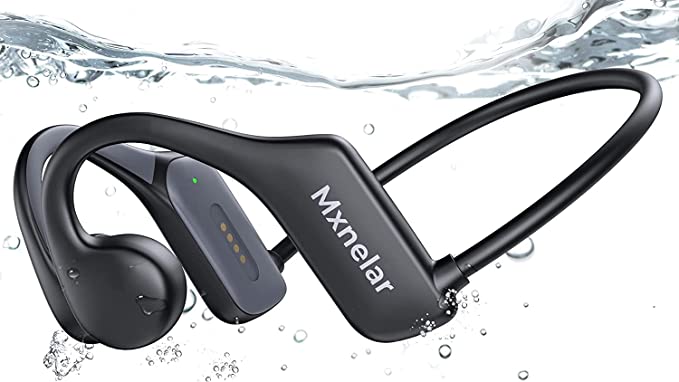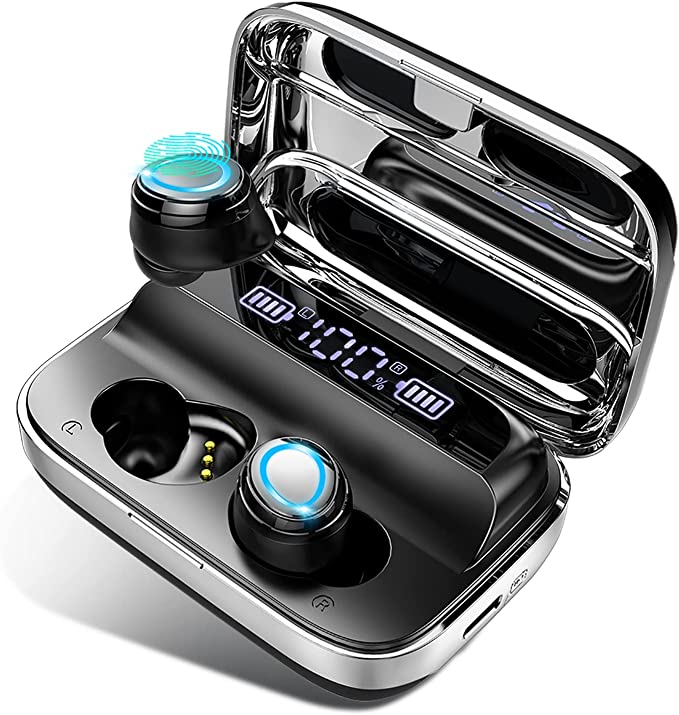The rhythm hits, your feet pound the pavement, the world fades just enough for you to find your zone. Music is the near-universal fuel for motion, the invisible coach pushing us through that extra mile, that final set. But what happens when your chosen path leads you not down a road, but into the water? For swimmers, the quest for an accompanying soundtrack has often been met with silence, or worse, the frustration of crackling, waterlogged earbuds. The very element they move through acts as a barrier to the soundwaves they crave.
Enter technologies designed to sidestep these obstacles. Devices like the Relxhome AS19 Bone Conduction Headphones represent an intriguing approach, combining multiple pieces of tech to try and crack the code of reliable audio, both on land and, crucially, underwater. But how does it work? It’s a fascinating journey that starts not in the ear canal, but within the very bones of your skull.

Whispers Through Your Bones: Unpacking Bone Conduction
Hearing Without Your Ears? Almost.
Think about how you normally hear. Sound waves travel through the air, funnel into your ear canal, vibrate your eardrum, and pass through tiny bones in the middle ear to reach the cochlea, the inner ear’s spiral-shaped chamber where vibrations are finally translated into electrical signals your brain understands as sound. This is air conduction, the pathway we rely on most.
Bone conduction offers an alternative route. Instead of sending sound waves down the ear canal, it transmits sound through vibration. Imagine gently placing a vibrating tuning fork against the bone behind your ear, or even your teeth – you’ll “hear” the tone, even if your ears are plugged. Bone conduction devices work on a similar principle. According to Relxhome, the AS19 headphones employ this technology. Typically, this involves small transducers resting on the cheekbones, just in front of the ears. These transducers generate micro-vibrations that travel directly through the bones of your skull to the inner ear, bypassing the eardrum and middle ear entirely.
The most immediate and perhaps profound consequence of this approach is what Relxhome calls the Open-Ear Design. Because sound isn’t being funneled into your ear canals, they remain completely unobstructed. This isn’t just about avoiding the plugged-up sensation some people dislike with traditional earbuds; it fundamentally changes how you interact with the soundscape around you.

The World Stays Open: The Safety & Comfort Equation
Hear Your Music, Hear the Truck.
That open-ear design is more than a neat trick; it’s a core feature with significant implications, particularly for safety and comfort during activities. When your ear canals aren’t blocked, you remain connected to your surroundings. The Relxhome product description emphasizes this: the ability to hear “what’s going on around you.”
Think about the practical applications. If you’re running on city streets, you can still hear approaching cars, bicycle bells, or shouted warnings. On a hiking trail, you remain aware of other hikers, wildlife, or changing weather sounds. Even during a daily commute or while driving (where local laws permit headphone use), maintaining auditory awareness is crucial. Traditional headphones, especially noise-canceling ones, create a bubble of isolation which can be relaxing but potentially dangerous in dynamic environments. Bone conduction, as implemented in devices like the AS19, aims to offer a safer alternative, allowing you to enjoy audio without sacrificing awareness.
Comfort is another potential benefit. For individuals who find in-ear buds uncomfortable, causing pressure or irritation over long periods, the external placement of bone conduction transducers can be a welcome relief.
However, it’s worth understanding the inherent physics. Because the vibrations travel through bone but also inevitably cause some vibration of the device casing itself, a degree of sound can “leak” into the surrounding air, potentially audible to those nearby in quiet environments. Furthermore, the way sound is perceived via bone conduction can sometimes differ in timbre or richness compared to high-fidelity air conduction headphones, especially in the lower bass frequencies. It’s a different way of experiencing sound, one that prioritizes environmental awareness alongside personal audio.

Taking the Plunge: Waterproofing Meets Aquatic Physics
Decoding IPX8 and Why Water Hates Bluetooth.
Now, let’s dive into the swimming pool scenario. The first major hurdle for any electronic device near water is, well, the water itself. Electronics and water generally don’t mix well. To combat this, devices designed for aquatic use rely on robust waterproofing, often rated using the Ingress Protection (IP) standard.
The Relxhome AS19 boasts an IPX8 rating. Let’s break that down. “IP” stands for Ingress Protection. The first digit (represented by ‘X’ here) rates protection against solid particles (like dust) – ‘X’ means it hasn’t been specifically rated for dust ingress. The second digit, ‘8’, rates protection against liquids. An ‘8’ is one of the highest standard ratings, signifying that the device is protected against continuous immersion in water under conditions specified by the manufacturer. According to the Relxhome description, the AS19 headphones “can work in the water for up to two hours” and can be submerged. This level of protection is essential for a device intended for swimmers.
But simply surviving submersion isn’t enough to deliver music wirelessly underwater. Here, we encounter a fundamental challenge rooted in physics: water is notoriously hostile to the radio waves used by technologies like Bluetooth.
Bluetooth operates in the 2.4 GHz frequency band, similar to Wi-Fi. In air, these radio waves travel relatively freely, allowing your phone to connect to headphones several feet away. Water, however, is a much denser medium and is very effective at absorbing and scattering these radio waves. Think of trying to shine a flashlight beam through murky water versus clear air – the light gets absorbed and dispersed quickly in the water. Similarly, Bluetooth signals weaken drastically almost immediately upon entering water. This is why trying to stream music from a phone sitting on the pool deck to headphones on your head while swimming usually results in a frustratingly intermittent or non-existent connection the moment your head goes underwater.
The Offline Detour: Why MP3 is King Underwater
When Old School Tech Saves the Day.
How does the Relxhome AS19 overcome this seemingly insurmountable barrier of aquatic physics? It employs a clever, albeit more traditional, solution: it incorporates a built-in MP3 player.
This transforms the headphones from solely relying on a live wireless connection to being a self-contained music playback device. Instead of trying (and failing) to receive a weak Bluetooth signal underwater, you load your music files directly onto the headphones’ internal memory beforehand. The Relxhome AS19 is described as having 32GB of built-in memory. How many songs is that? The listing suggests “up to 8,000 songs,” but this is a rough estimate highly dependent on the audio file format and compression quality (bitrate). Higher quality files take up more space. According to the product Q&A, compatible file types include common formats like MP3, WAV, WMA, AAC, and FLAC. Loading music typically involves connecting the headphones to a computer via the provided magnetic charging cable, where they appear as a storage drive, allowing you to drag and drop your audio files.
Once the music is loaded, you switch the headphones from Bluetooth mode to MP3 mode. This is crucial. As Relxhome explicitly states, “Please use MP3 mode when swimming, Bluetooth mode can’t transmit signals underwater.” In MP3 mode, the headphones simply access and play the files stored locally, completely bypassing the problematic Bluetooth link. This provides a reliable, uninterrupted stream of music directly to your inner ear via bone conduction, regardless of whether your head is above or below the water’s surface.
Of course, this approach has its own trade-offs compared to the convenience of modern streaming. You need to own the music files (or convert legally acquired streams to compatible formats, which can be complex and legally grey depending on the service). It requires the extra step of connecting to a computer and managing files. You can’t stream live radio, podcasts directly from a streaming app, or take calls while in MP3 mode. However, for the specific challenge of listening to music while actively swimming, this offline MP3 capability, combined with the IPX8 waterproofing and bone conduction, presents a robust and pragmatic solution where Bluetooth fails.

Beyond the Pool Deck: Everyday Features
More Than Just a Swim Buddy.
While the swimming capability is a standout feature, the Relxhome AS19 is designed to function as an everyday sports headphone as well. For dry-land activities, it utilizes Bluetooth 5.3. This standard aims to provide a stable and efficient wireless connection to your phone or other Bluetooth-enabled devices, allowing you to stream music, listen to podcasts, or take calls when you’re running, cycling, at the gym, or just relaxing.
Battery life is always a key consideration for wireless headphones. Relxhome claims the AS19 offers “up to 10 hours” of playtime on a single charge. It’s important to interpret “up to” realistically – actual battery life will vary significantly based on factors like volume level, whether you’re using Bluetooth or MP3 mode (MP3 playback might be slightly more power-efficient), and ambient temperature. Still, a potential 10 hours should cover most workouts or even a full day of intermittent use.
The physical design also caters to active use. The manufacturer highlights a “secure fit” intended to keep the headphones stable during intense training, though fit is subjective and depends on individual head shape and size. They are also described as lightweight, with an item weight listed at 1.13 ounces (about 32 grams), minimizing perceived burden during activity. Charging is handled via a magnetic cable, which can be more convenient and potentially offer better water resistance around the charging port compared to traditional USB ports.

Conclusion: Sound, Adapted
Engineering Audio for Every Element.
The Relxhome AS19 headphones, based on the features described by the manufacturer, exemplify how different technologies can be thoughtfully combined to address the specific needs and overcome the unique challenges faced by active individuals, especially swimmers. The core innovation lies not in any single piece of tech, but in their synergy.
Bone conduction offers a pathway to personal audio while maintaining crucial awareness of the external world, a potential safety boon for runners, cyclists, and others navigating dynamic environments. The robust IPX8 waterproofing grants access to the aquatic realm. And the integrated MP3 player cleverly circumvents the fundamental physical limitations of Bluetooth underwater, providing a reliable method for swimmers to finally bring their motivating soundtracks along for the laps.
It represents a form of adaptive technology – sound delivery engineered to function across different elements and activities. While performance specifics like precise audio fidelity, real-world battery endurance, and long-term durability ultimately rely on the manufacturer’s execution and can only be truly assessed through independent testing, the concept presented by the Relxhome AS19 illustrates a compelling blend of acoustics, material science, and digital storage aimed squarely at enhancing the athletic experience, wherever it may lead – through air, or through water.



